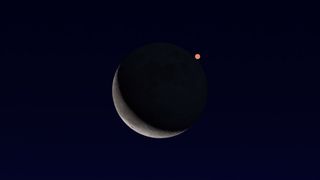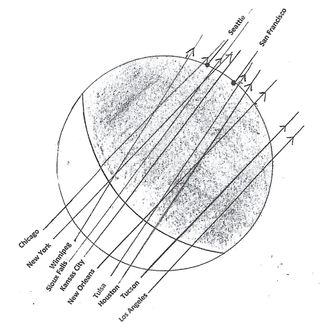As the waning crescent moon rises in the small hours of the morning of Tuesday, Feb. 18, skywatchers will be preparing for an unusual event. That morning the moon glides in front of orange, starlike planet Mars for viewers in much of central and eastern North America, in what is known as an occultation.
Parts of the western and central U.S. and Canada will be able to view both the disappearance and reappearance of the Red Planet in a dark or twilight sky. However, from western Canada, the Pacific Northwest and northern portions of California and Nevada, only the end of the occultation will be seen, since Mars will already be behind the moon when it rises around 3:30 a.m. local time. On the other hand, across the Eastern U.S., the planet will both disappear and emerge after sunup.
Under reasonably dark skies, this event can be watched over western locations with the naked eye or binoculars, although a telescope will provide the best views. Over the Desert Southwest and parts of the Rocky Mountain States along and east of the Continental Divide, the entire event will occur under a dark sky, but will take place very low in the east-southeast; an open view of the horizon is required. Right now, Mars is relatively faint at magnitude +1.2 and will be dimmed further by its low altitude, but it should not be hard to spot.
Related: The brightest planets in February's night sky: How to see them (and when)

Near and immediately east (right) of a line extending roughly from Santa Barbara, California to Idaho Falls, Idaho to Havre, Montana, the bright limb of the moon occults the planet when it is still too low to view. But Mars' reappearance from behind the moon's dark limb will be much more observable, because the moon will be higher above the horizon and the planet won't be washed out by the crescent's bright glare.
Unlike the pinpoint image of a star, which upon interaction with the moon appears to vanish or reappear as if you've clicked a switch, the larger apparent size of Mars causes it to disappear or emerge more gradually. About 15 seconds should elapse for the moon to fully cover (or uncover) the tiny disk of Mars after the edges of the two bodies appear to make contact. But the duration will be slightly longer for locations well to the north or south, where the occultation is not nearly central.
Mars currently shows a gibbous disk with an apparent diameter of 5.1 arc seconds. The first speck of light from the Red Planet when it reappears from behind the moon will be at the moon's dark limb and can be spotted by an observer looking in the right place with a small telescope. Mars will emerge into view as a tiny, brilliant fiery blob — seemingly like a burst of lava from some great lunar volcano.

In order to help observers anticipate where Mars will disappear (behind the moon's bright limb) and reappear (from behind the moon's dark limb), the accompanying diagram shows the apparent path of Mars as seen from various cities. The numbers specify the cities as given in this list. For some locations (such as San Francisco, #17), the disappearance will occur before moonrise, so its track on the left is not shown.
More difficult farther east
As one heads east, the occultation will take place after the break of dawn and the advance of morning twilight. Across the northern and central Great Plains, as well as the western half of Oklahoma and Texas, Mars will disappear in a dark sky, but twilight will be well advanced when it reappears. Binoculars or a telescope will be needed to see the emergence from behind the moon's dark limb. From the Great Lakes, Greater Ohio Valley and the Deep South, Mars will disappear in a twilight sky and reappear after sunrise.
And for New England, upstate New York, Toronto and Montreal, the greater New York City area and New Jersey, Middle Atlantic Coast, Piedmont and Southeast Coast including Florida, the entire occultation will be a daytime affair.
Trying to see the occultation from these regions will prove to be quite a challenge to say the least!
Prior to sunrise, you'll see Mars sitting less than a couple of degrees to the left of the 24% illuminated lunar crescent. Moving at roughly its own apparent diameter per hour, the moon will appear to gradually creep closer to Mars as they slowly ascend and the background sky turns progressively brighter. With the naked eye alone, you'll probably lose sight of Mars about a half hour before sunrise, though it still should be readily visible through binoculars and small telescopes. To continue seeing it after sunrise however, will require a very clear (haze-free) day. The surface brightness of Mars (amount of light per square arc second) is about equal to that of the moon.
In the accompanying table, predicted times at 28 cities are given for this "Mars eclipse." Also included is whether the event in question takes place in a dark sky, at mid-twilight (30 to 60 minutes before sunrise), bright twilight (30 minutes to just a few minutes before sunrise), near sunrise (within a couple of minutes of sunup) and daytime (after sunrise).
For San Francisco and Seattle, where no time is listed under disappearance, that event occurs before moonrise.
| Disapearance | Reappearance | |
|---|---|---|
| Atlanta, Georgia | 7:07 a.m. Daytime | 8:45 a.m. Daytime |
| Austin, Texas | 5:46 a.m. Dark sky | 7:09 a.m. Near sunrise |
| Boston, Massachusetts | 7:44 a.m. Daytime | 9:10 a.m. Daytime |
| Chicago, Illinois | 6:07 a.m. Bright twilight | 7:35 a.m. Daytime |
| Denver, Colorado | 4:41 a.m. Dark sky | 6:02 a.m. Mid-twilight |
| Gander, Newfoundland, Canada | 9:48 a.m. Daytime | 11:00 a.m. Daytime |
| Helena, Montana | 5:57 a.m. Dark sky | |
| Houston, Texas | 5:48 a.m. Dark sky | 7:15 a.m. Daytime |
| Kansas City, Missouri | 5:52 a.m. Dark sky | 7:02 a.m. Daytime |
| Las Vegas, Nevada | 3:36 a.m. Dark sky | 4:40 a.m. Dark sky |
| Los Angeles, California | 3:38 a.m. Dark sky | 4:29 a.m. Dark sky |
| Memphis, Tennessee | 5:57 a.m. Mid-twilight | 7:30 a.m. Daytime |
| Mexico City, Mexico | 6:03 a.m. Dark sky | 6:43 a.m. Bright twilight |
| Miami, Florida | 7:15 a.m. Daytime | 8:57 a.m. Daytime |
| Monterrey, Mexico | 5:47 a.m. Dark sky | 6:56 a.m. Bright twilight |
| Montreal, Quebec, Canada | 7:39 a.m. Daytime | 8:59 a.m. Daytime |
| New Orleans, Louisiana | 5:55 a.m. Mid-twilight | 7:29 a.m. Daytime |
| New York, New York | 7:36 a.m. Daytime | 9:05 a.m. EST Daytime |
| Quebec City, Quebec, Canada | 7:46 a.m. Daytime | 9:03 a.m. Daytime |
| Salt Lake City, Utah | 4:37 a.m. Dark sky | 5:51 a.m. Dark sky |
| San Francisco, California | 4:30 a.m. Dark sky | |
| Seattle, Washington | 4:47 a.m. Dark sky | |
| Sioux Falls, South Dakota | 5:53 a.m. Dark sky | 6:18 a.m. Near sunrise |
| Toronto, Ontario, Canada | 7:26 a.m. Daytime | 8:50 a.m. Daytime |
| Tucson, Arizona | 4:38 a.m. Dark sky | 5:40 a.m. Dark sky |
| Tulsa, Oklahoma | 5:49 a.m. Dark sky | 7:17 a.m. Near sunrise |
| Washington, D.C. | 7:27 a.m. Daytime | 9:00 a.m. Daytime |
| Winnipeg, Manitoba, Canada | 6:02 a.m. Dark sky | 7:18 a.m. Bright twilight |
But wait, there's more!
For a listing of predicted times for over 700 locations, go to: http://occultations.org/documents/2020/20200218MarsWorld.txt
For a map depicting the region of visibility of this occultation, go to: http://occultations.org/documents/2020/20200218MarsWorldMap.jpg
The turquoise curves show where the disappearance or reappearance occurs at moonrise (left side) or moonset (right side); there is no northern limit as that misses the Earth to the north. The southern limit of the occultation, from which a partial occultation will be visible in a strip about 5 miles wide, crosses the n.e. Pacific Ocean and southern Mexico (white line, event at night), Central America (dark blue line that's hardly visible, event during morning twilight), and northern S. America and the Atlantic Ocean (red dotted line, event during daylight).
Times and map are courtesy of Mr. David Dunham, International Occultation Timers association.
Joe Rao serves as an instructor and guest lecturer at New York's Hayden Planetarium. He writes about astronomy for Natural History magazine, the Farmers' Almanac and other publications. Follow us on Twitter @Spacedotcom and on Facebook.
"occur" - Google News
February 17, 2020 at 07:54PM
https://ift.tt/2HusY7n
The moon will 'eclipse' Mars before dawn Tuesday! Here's how to see it. - Space.com
"occur" - Google News
https://ift.tt/2UoDqVw
Shoes Man Tutorial
Pos News Update
Meme Update
Korean Entertainment News
Japan News Update
Bagikan Berita Ini















0 Response to "The moon will 'eclipse' Mars before dawn Tuesday! Here's how to see it. - Space.com"
Post a Comment